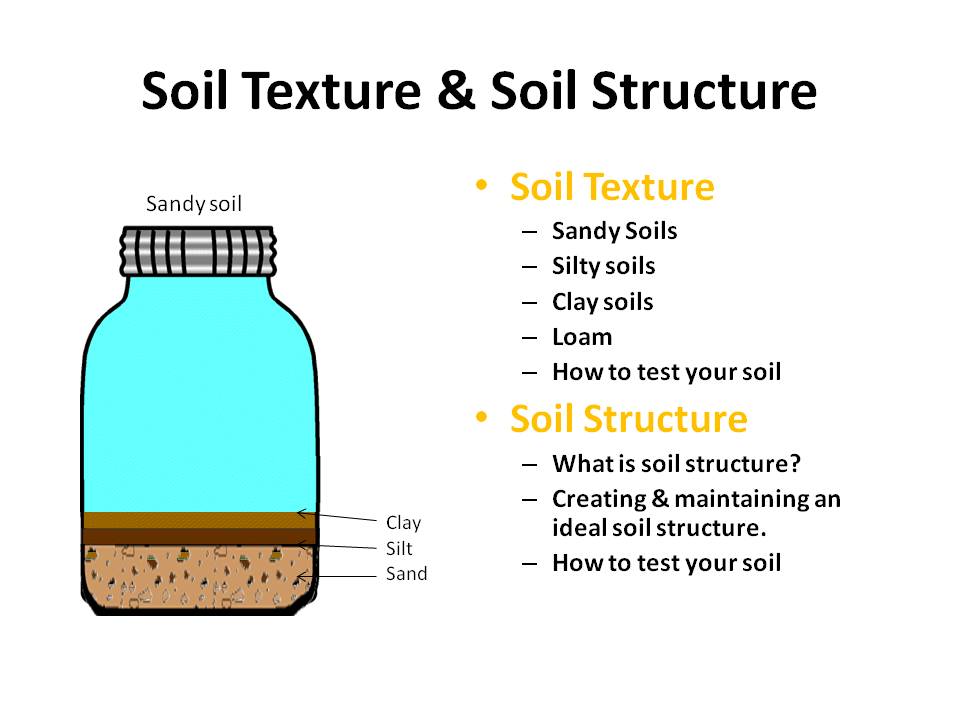
Soil Texture
Is one of the most important things to know about your soil. Soil is comprised of different sizes of mineral particles. The relative amounts of each of these different sized particles constitute a soils texture. There are 3 main soil textures; sandy, silty or clayey and there are pluses and minuses to each one.
- Sandy Soils: Have a gritty texture. Their larger particle size serves to create larger spaces between particles, and this translates to faster drainage and easy root penetration. Sandy soils are easy to work, do not clump, are quick to warm up in the spring and can be cultivated when wet. Their excellent drainage also helps to keep plants relatively free from soil borne diseases. On the downside they do not hold water and nutrients well and require more frequent fertilizing and watering.
- Silty soils: Have a silky feel to them and like sand do not clump, but this consistency puts silty soils at high risk of erosion. They are slower to warm up in the spring and are harder to cultivate when wet. On the positive side they are fairly easy to work and hold nutrients and water better than sand.
- Clay soils: Are almost cement like when dry. They are very slow to drain and should never be cultivated when wet. These soils compact very easy and are difficult to work. On the upside they are excellent at holding in water and nutrients and require less frequent watering and fertilizing.
- Loam: Is the technical term used to describe the ideal soil texture. It consists of a mixture of 30-40% sand……30-40% silt…….and 8-28% clay. This mix provides good aeration, excellent drainage, is easy to work and will hold nutrients well. Unfortunately loam rarely occurs on its own. How to test your soil texture:
- To quickly identify a sandy, silty or clayey soil, squeeze a handful of moist dirt in your hand. If it makes a ball then you are not sandy, but if that ball does not easily crumble apart then you likely have a clay soil. For a much more informative test try the glass jar test.
Get a container and collect a small sample of soil from various parts of your yard. (To do this dig 5-6 small holes approx. 6” deep. Then cut a long slice of soil from the side of each hole.) Mix this soil together and add about 1c. of this soil mix to a glass jar, removing any pebbles, sticks, or plant parts. Fill the remainder of the jar nearly to the top with water and shake or stir well. Set the jar in a place where it will not be disturbed and allow it to settle for 24 hours.
You will notice definite layers beginning to form. The bottom layer will be sand (the heaviest particles). The middle layer will consist of silt and the top layer will be clay (your finest particles).
To calculate the percentages of each layer, measure the height of each layer; divide the total height into the height of one layer; multiply your result by 100. If the jar on this slide where to be measured and calculated the results would probably indicate about 60% sand; 20% silt; and 20% clay, making it a sandy soil.
The most effective way to improve your soils texture is to add plenty of organic matter. Organic matter helps sandy soils to retain moisture and nutrients; for silty soils it helps the soil to stick together better reducing erosion; for clay soils it helps to improve aeration and drainage.
Soil Structure
Deals with how a soil hangs together. Ideally you want loose crumbs and clods. If you were to squeeze a handful of soil in your hand it should form a loose ball, but with a light tap it should easily break apart. This type of structure provides adequate porosity, no matter what your soil texture is. Soils with good structure are able to absorb more rainwater, drain freely and roots and soil organisms are able to move through the soil with greater ease.
A synergistic partnership between organic matter and soil organisms is the main agent behind good soil structure. As organic matter is broken down by earth worms and soil microorganisms, small air pockets are created in the soil. Additionally, the decomposing matter is turned into gelatinous substances that serve to gently hold soil particles together. Another contributor is plant roots and fungi that serve to push soil particles together as they push through. They also manufacture gummy substances that help to hold particles loosely together.
Other tips for creating and maintaining good soil structure include cultivating the soil only when moist (not wet); Applying a layer of mulch to prevent compaction from pounding rains; minimizing roto tilling and other forms of cultivation, both of which will kill off many of your soil organisms and break up the desirable soil crumbs; add compost and/or manures regularly.
How To Test Your Soil Structure
The best way to test your soil is to grab a shovel and dig a hole about 1’ in depth. Carefully examine the soil. Does the soil that was removed consist of small ½” crumbs and do larger clumps break apart easily. This would indicate a good soil structure. Is the soil easy to dig or is it crusted on the top or very compacted lower down. This would indicate poor soil structure.
Another test you can perform that helps to determine the stability of your soil (stability referring to how well the soil crumbs remain crumbly); is to place a handful of soil into 2 glasses. Then gently pour water into one of the glasses to cover the soil. If the crumbs hold together when wet, you have a stable structure.
Photo Credit: photo/slide created by the author.
All rights reserved


One thought on “SOIL TEXTURE AND SOIL STRUCTURE”